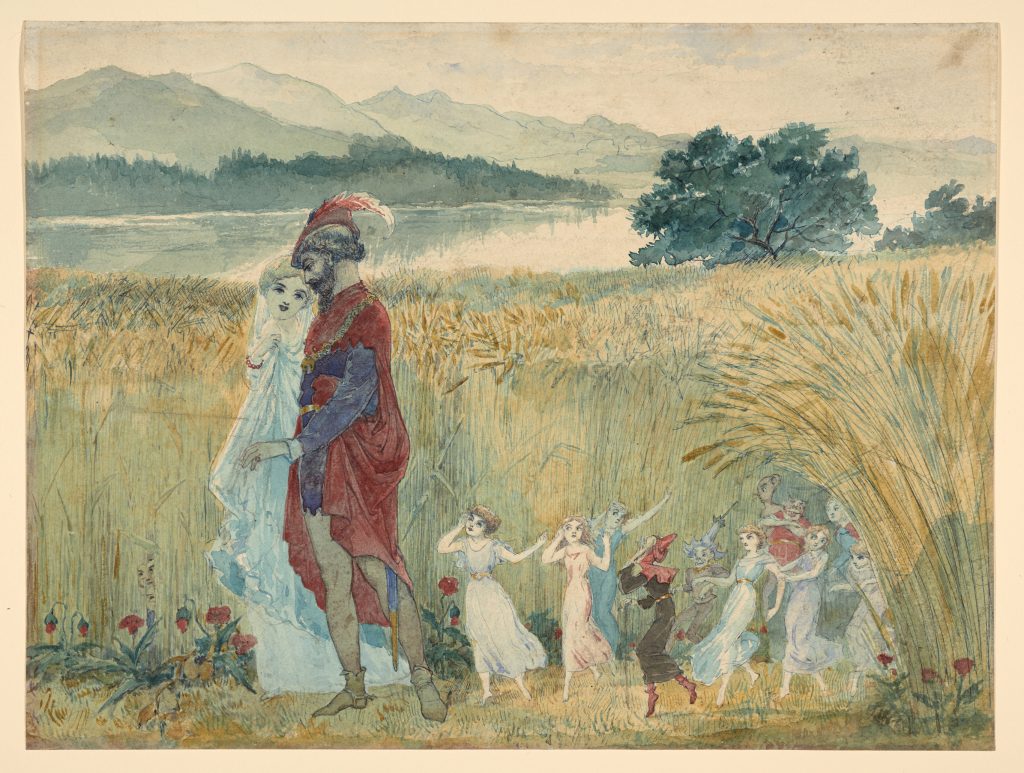Faeries and Fantasy
The San Marino Tribune reports that The Huntington features "the forgotten father" of Sir Arthur Conan Doyle.
The Huntington Library is one of America's leading independent humanities research libraries, located in the San Marino suburb of Los Angeles, and also has one of the existing Sherlock Holmes story manuscripts, of "The Adventure of the Six Napoleons."
Often dismissed as the work of a madman, the colorful, faery-filled watercolors of Charles Altamont Doyle—produced during his time as an inmate at Montrose Royal Lunatic Asylum—have languished in relative obscurity for over a hundred years.
On display for the first time since 1980 and in honor of Father’s Day, the sixteen works in “The Unseen World of Charles Altamont Doyle” bring the forgotten father of Sir Arthur Conan Doyle, creator of Sherlock Holmes, out of the shadows and into a new light. The exhibition at The Huntington Library, Art Collections, and Botanical Gardens opened June 15 and goes to September 23, 2019.
Charles Altamont Doyle (1832-1893) produced numerous watercolors featuring faeries and mythical scenes during his time as an inmate at Montrose Royal Lunatic Asylum. His life provides a nuanced view of the historic family.
“The fact that Charles Doyle’s fairy pictures were produced while the artist was hospitalized has tended to obscure his active engagement with contemporary art,” The Huntington’s Associate Curator of British Art Melinda McCurdy told The Tribune. “They reveal him to be a skilled, if idiosyncratic, draftsman, with a sense of humor that was in line with that of his Victorian contemporaries.”
Doyle was born in London, England, on March 25, 1832. He was surrounded by an artistic family with his father John Doyle as a notable political cartoonist, older brother Richard “Dicky” Doyle as a famous illustrator and other brother a prominent artist went on to become the director of the National Gallery in Ireland, as noted by a study by the University of North Carolina Chapel Hill.
Doyle moved to Edinburgh, Scotland, at age 17 and started working as an architectural draftsman in the Scottish Office of Works. His most notable work was designing the Fountain at Holyrood Palace in Scotland, erected at the request of Queen Victoria. He served in the Scottish government for three decades, doing additional work on the side with illustrations for books and magazines.
Doyle married Mary Foley in 1855. Foley’s mother was the owner of a boarding house where Doyle resided. Doyle and Foley raised seven children together and their eldest son, Arthur Conan Doyle, went on to become a notable author and creator of Sherlock Holmes, the famous fictional detective.
Despite a rich family life, career and growing artistic talent, Doyle experienced strong feelings of inadequacy and low self-esteem. He turned to alcohol and his addiction caused his mental and physical health to decline over time, resulting in his losing his job at the Scottish Office of Works in June 1876. His condition eventually deteriorated into acute delirium tremens, with delusions and hallucinations. He also experienced bouts of epilepsy and depression. In 1881, he was committed to a mental institution in 1881. He would go on to spend the next 12 years in different asylums for those with mental illnesses.
During his time in these institutions, including the Montrose Royal Lunatic Asylum, Doyle was noted as creating some of his best artwork pieces. He filled numerous sketchbooks with watercolor drawings and sketches with pen and ink. His work primarily highlighted elves, faerie folk and other mythical themes. The illustrations also involved visual puns and clever wordplay. It was noted that Doyle crafted the artwork to show proof of his sanity, often sending pieces to his family as evidence of being wrongfully confined. However, Doyle remained in institutions for the rest of his life. In October 1893, Doyle experienced a severe epileptic fit which overpowered his weakened heart and led to his passing.
Sir Arthur Conan Doyle exhibited his father’s works in 1924, which brought praise from many critics. It was noted that author George Bernard Shaw felt his work was of such a quality that it could fill its own room in a national museum.
The Huntington acquired the works with assistance from The Friends in the 1960s in a gift from Princess Nina Conan Doyle, last of the royal Georgian clan of Mdivanis whose last husband Denis Conan Doyle was the son of Sir Arthur Conan Doyle.
As watercolors are delicately susceptible to light, they are never on long-term view and are only brought out for occasional special exhibitions around particular themes. They were last displayed in an exhibition at The Huntington called “Charles Doyle’s Fairyland,” curated by Robert Wark, former director of the art collections.
Image credit: Charles Altamont Doyle (British, 1832-1893), “The Eavesdroppers,” pen and watercolor over pencil. Gift of Princess Nina Mdivani Conan Doyle with assistance from The Friends. Image courtesy The Huntington Library, Art Collections, and Botanical Gardens

